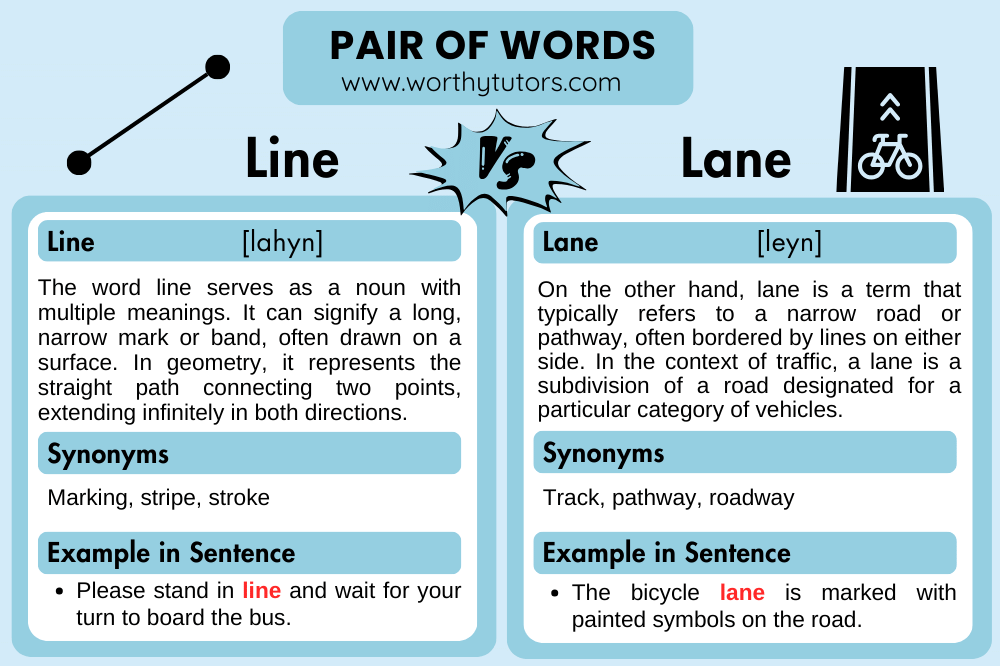
Differences Between Line and Lane
The beauty of language lies in its precision and the power it bestows upon us to articulate the world around us. Line and lane are two such words that, while often used interchangeably, have distinct meanings that enrich our conversations and writings. This article aims to dissect these terms, shedding light on their proper pronunciation, meanings, and usage in the English lexicon.
Line
Pronunciation
Line is pronounced as [lahyn], it rhymes with “fine” and “mine.”
Meaning of Line
“Line” is a noun that refers to a long, narrow mark or band, or a series of connected points extending in a particular direction.
Synonyms of Line
- Stroke
- Marking
- Stripe
Etymology and Explanation of Line
The etymology of “line” traces back to the Old English word “līne,” meaning “rope” or “cable.” The word line serves as a noun with multiple meanings. It can signify a long, narrow mark or band, often drawn on a surface. In geometry, it represents the straight path connecting two points, extending infinitely in both directions. In everyday language, a “line” can also refer to a row of people or objects arranged consecutively, such as in a queue.
Example in Sentences
- He drew a straight line from one end of the paper to the other.
- The train travels along the coastal line, offering breathtaking views of the ocean.
- Please stand in line and wait for your turn to board the bus.
Lane
Pronunciation
Lane is pronounced as [leyn], it rhymes with “main” and “plane.”
Meaning of Lane
A “lane” is a narrow road or path, typically with defined boundaries, used for vehicular or pedestrian traffic.
Synonyms of Lane
- Roadway
- Pathway
- Track
Etymology and Explanation of Lane
The etymology of “lane” dates back to the Middle English word “lane,” which means “narrow way” or “alley.” On the other hand, lane is a term that typically refers to a narrow road or pathway, often bordered by lines on either side. In the context of traffic, a lane is a subdivision of a road designated for a particular category of vehicles or for a specific direction of travel.
Example in Sentences
- The bicycle lane is marked with painted symbols on the road.
- Drivers should stay in their designated lane while navigating the highway.
- The jogging lane in the park is reserved for pedestrians and runners.
Usage in Idioms and Phrases
“Line” and “lane” enrich the language further when used in idiomatic expressions and phrases. “Crossing the line” implies going beyond acceptable behavior, while “staying in one’s lane” advises against meddling in others’ affairs.
Conlusion
To conclude, “line” and “lane” are more than mere words; they are vessels of meaning, each carrying its own weight and significance. They guide us in understanding the boundaries and paths, both literal and metaphorical, that shape our world.
Fill in the Blank Exercise
- She waited patiently in _____ at the checkout counter. (Line/Lane)
- The bicycle _____ is reserved for cyclists on the road. (Line/Lane)
- Please stay in your designated _____ while driving on the highway. (Line/Lane)
- The fishing boat cast its _____ into the water, hoping for a catch. (Line/Lane)
- The jogging _____ in the park is ideal for morning workouts. (Line/Lane)

About Authoress
Mahnoor Jehangir is a seasoned educator and linguist, specializing in English language and literature. With a master’s degree in English and applied linguistics, Mahnoor serves as a subject lead, while also indulging her passion for writing, exploring the nuances of language and storytelling.